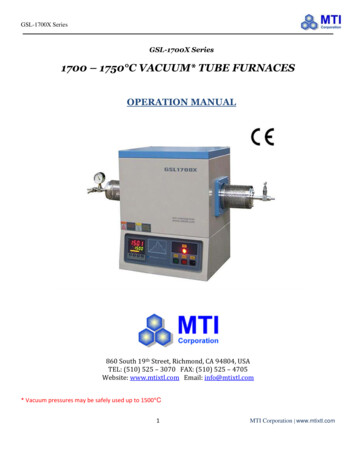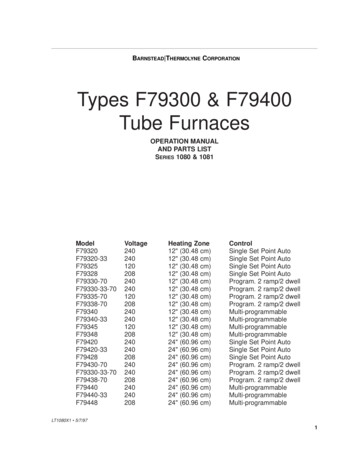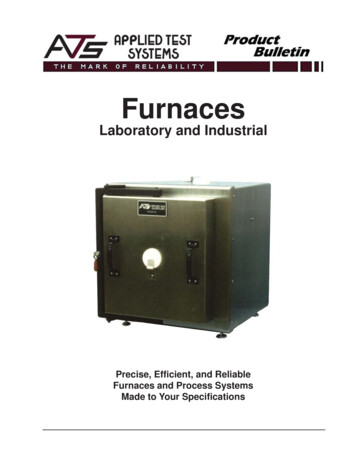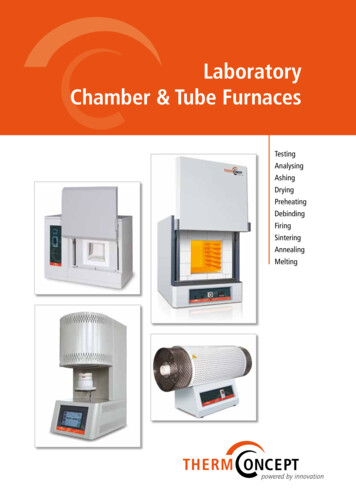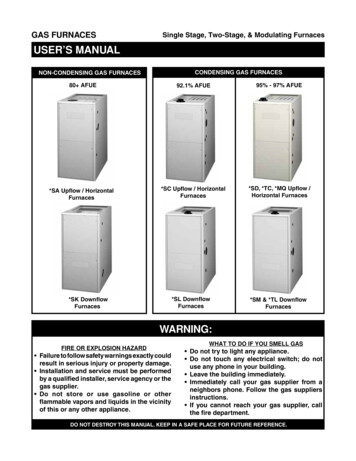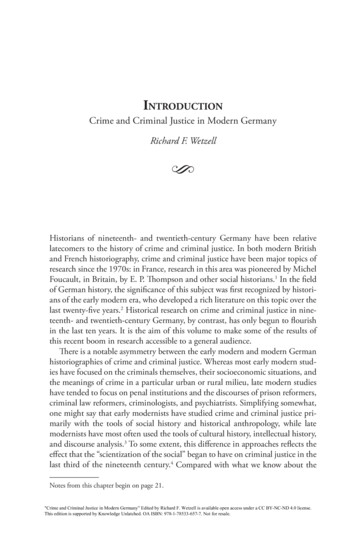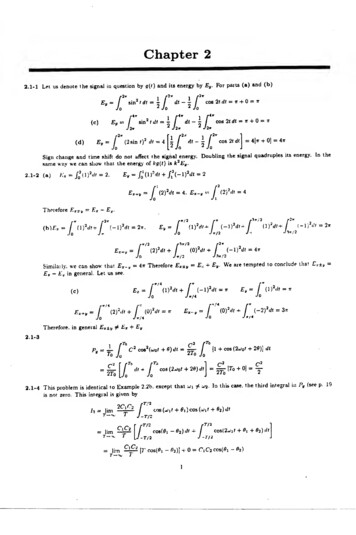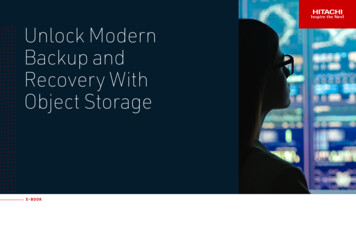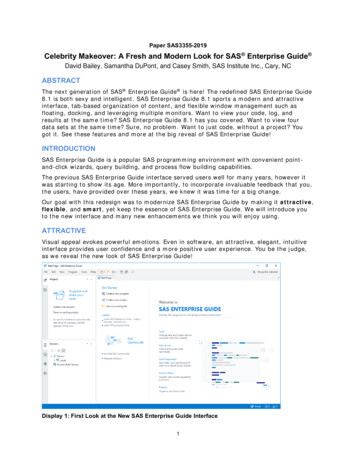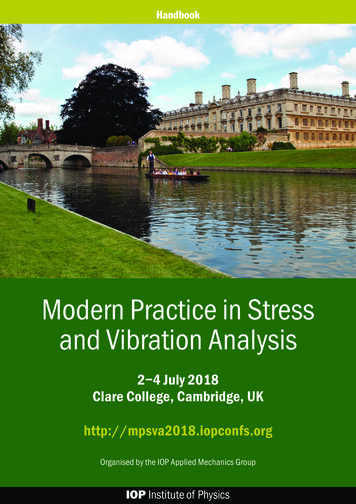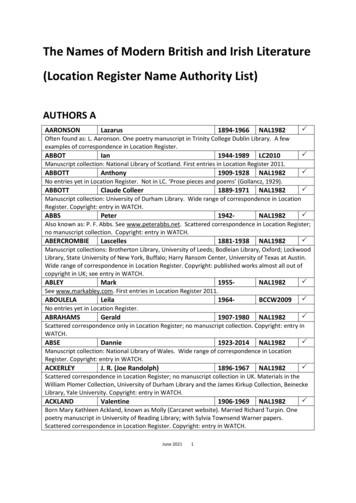
Transcription
Thermal Energy Equipment: Furnaces and RefractoriesFURNACES AND REFRACTORIES1. INTRODUCTION. 12. TYPES OF FURNACES, REFRACTORIES AND INSULATION . 53. ASSESSMENT OF FURNACES . 184. ENERGY EFFICIENCY OPPORTUNITES . 275. OPTIONS CHECKLIST . 356. WORKSHEETS. 357. REFERENCES . 361. INTRODUCTIONThis section introduces furnaces and refractories and explains the various design and operationaspects.1.1 What is a furnace?A furnace is an equipment used to melt metals for casting or to heat materials to change theirshape (e.g. rolling, forging) or properties (heat treatment).Since flue gases from the fuel come in direct contact with the materials, the type of fuel chosen isimportant. For example, some materials will not tolerate sulphur in the fuel. Solid fuels generateparticulate matter, which will interfere the materials placed inside the furnace. For this reason: Most furnaces use liquid fuel, gaseous fuel or electricity as energy input. Induction and arc furnaces use electricity to melt steel and cast iron. Melting furnaces for nonferrous materials use fuel oil. Oil-fired furnaces mostly use furnace oil, especially for reheating and heat treatment ofmaterials. Light diesel oil (LDO) is used in furnaces where sulphur is undesirable.Furnace ideally should heat as much of material as possible to a uniform temperature with theleast possible fuel and labor. The key to efficient furnace operation lies in complete combustionof fuel with minimum excess air. Furnaces operate with relatively low efficiencies (as low as 7percent) compared to other combustion equipment such as the boiler (with efficiencies higherthan 90 percent. This is caused by the high operating temperatures in the furnace. For example, afurnace heating materials to 1200 oC will emit exhaust gases at 1200 oC or more, which results insignificant heat losses through the chimney.Energy Efficiency Guide for Industry in Asia - www.energyefficiencyasia.org UNEP 20061
Thermal Energy Equipment: Furnaces and RefractoriesAll furnaces have the following components as shown in Figure 1 (Carbon Trust, 1993): Refractory chamber constructed of insulating materials to retain heat at high operatingtemperatures. Hearth to support or carry the steel, which consists of refractory materials supported by asteel structure, part of which is water-cooled. Burners that use liquid or gaseous fuels to raise and maintain the temperature in the chamber.Coal or electricity can be used in reheating furnaces. Chimney to remove combustion exhaust gases from the chamber Charging and discharging doors through which the chamber is loaded and unloaded. Loadingand unloading equipment include roller tables, conveyors, charging machines and furnacepushers.Figure 1: Typical Furnace Components (The Carbon Trust, 1993)1.2 What are refractories? 1Any material can be described as a ‘refractory,’ if it can withstand the action of abrasive orcorrosive solids, liquids or gases at high temperatures. The various combinations of operatingconditions in which refractories are used, make it necessary to manufacture a range of refractorymaterials with different properties. Refractory materials are made in varying combinations andshapes depending on their applications. General requirements of a refractory material are: Withstand high temperatures Withstand sudden changes of temperatures Withstand action of molten metal slag, glass, hot gases, etc Withstand load at service conditions1Section 1.2 is taken (with edits) from Energy Efficiency in Thermal Utilities, 2005 with permission from the Bureau of EnergyEfficiency, Ministry of Power, India.Energy Efficiency Guide for Industry in Asia - www.energyefficiencyasia.org UNEP 20062
Thermal Energy Equipment: Furnaces and Refractories Withstand load and abrasive forcesConserve heatHave low coefficient of thermal expansionShould not contaminate the material with which it comes into contactTable 1 compares the thermal properties of typical high density and low density refractorymaterials.Table 1. Typical Refractory Properties (The Carbon Trust, 1993)PropertyThermal conductivity (W/m K)Specific heat (J/kg K)Density (kg/m3)High Thermal Mass(High density refractories)1.210002300Low Thermal Mass(Ceramic fiber)0.31000130Depending on the area of application such as boilers, furnaces, kilns, ovens etc, temperatures andatmospheres encountered different types of refractories are used. Typical installations ofrefractories are shown in Figure 2.Figure 2a. Refractory lining of a furnacearch (BEE, 2005)Figure 2b. Refractory walls of a furnaceinterior with burner blocks (BEE, 2005)Some of the important properties of refractories are:Melting point: Pure substances melt instantly at a specific temperature. Most refractory materialsconsist of particles bonded together that have high melting temperatures. At high temperatures,these particles melt and form slag. The melting point of the refractory is the temperature at whicha test pyramid (cone) fails to support its own weight.Size: The size and shape of the refractories is a part of the design of the furnace, since it affectsthe stability of the furnace structure. Accurate size is extremely important to properly fit therefractory shape inside the furnace and to minimize space between construction joints.Bulk density: The bulk density is useful property of refractories, which is the amount ofrefractory material within a volume (kg/m3). An increase in bulk density of a given refractoryincreases its volume stability, heat capacity and resistance to slag penetration.Energy Efficiency Guide for Industry in Asia - www.energyefficiencyasia.org UNEP 20063
Thermal Energy Equipment: Furnaces and RefractoriesPorosity: The apparent porosity is the volume of the open pores, into which a liquid canpenetrate, as a percentage of the total volume of the refractory. This property is important whenthe refractory is in contact with molten charge and slag. A low apparent porosity prevents moltenmaterial from penetrating into the refractory. A large number of small pores is generallypreferred to a small number of large pores.Cold crushing strength: The cold crushing strength is the resistance of the refractory tocrushing, which mostly happens during transport. It only has an indirect relevance to refractoryperformance, and is used as one of the indicators of abrasion resistance. Other indicators used arebulk density and porosity.Pyrometric cones and Pyrometric cones equivalent (PCE): The ‘refractoriness’ of (refractory)bricks is the temperature at which the refractory bends because it can no longer support its ownweight. Pyrometric cones are used in ceramic industries to test the refractoriness of the(refractory) bricks. They consist of a mixture of oxides that are known to melt at a specificnarrow temperature range. Cones with different oxide composition are placed in sequence oftheir melting temperature alongside a row of refractory bricks in a furnace. The furnace is firedand the temperature rises. One cone will bends together with the refractory brick. This is thetemperature range in oC above which the refractory cannot be used. This is known as PyrometricCone Equivalent temperatures. (Figure 3)Figure 3: Pyrometric Cones(Bureau of Energy Efficiency, 2004)Creep at high temperature: Creep is a time dependent property, which determines thedeformation in a given time and at a given temperature by a refractory material under stress.Volume stability, expansion, and shrinkage at high temperatures: The contraction or expansionof the refractories can take place during service life. Such permanent changes in dimensions maybe due to: The changes in the allotropic forms, which cause a change in specific gravity A chemical reaction, which produces a new material of altered specific gravity The formation of liquid phase Sintering reactionsEnergy Efficiency Guide for Industry in Asia - www.energyefficiencyasia.org UNEP 20064
Thermal Energy Equipment: Furnaces and Refractories Fusion dust and slag or by the action of alkalies on fireclay refractories, to form alkalialumina silicates. This is generally observed in blast furnaces.Reversible thermal expansion: Any material expands when heated, and contracts when cooled.The reversible thermal expansion is a reflection on the phase transformations that occur duringheating and cooling.Thermal conductivity: Thermal conductivity depends on the chemical and mineralogicalcomposition and silica content of the refractory and on the application temperature. Theconductivity usually changes with rising temperature. High thermal conductivity of a refractoryis desirable when heat transfer though brickwork is required, for example in recuperators,regenerators, muffles, etc. Low thermal conductivity is desirable for conservation of heat, as therefractory acts as an insulator. Additional insulation conserves heat but at the same timeincreases the hot face temperature and hence a better quality refractory is required. Because ofthis, the outside roofs of open-hearth furnaces are normally not insulated, as this could cause theroof to collapse. Lightweight refractories of low thermal conductivity find wider applications inlow temperature heat treatment furnaces, for example in batch type furnaces where the low heatcapacity of the refractory structure minimizes the heat stored during the intermittent heating andcooling cycles. Insulating refractories have very low thermal conductivity. This is usuallyachieved by trapping a higher proportion of air into the structure. Some examples are: Naturally occurring materials like asbestos are good insulators but are not particularly goodrefractories Mineral wools are available which combine good insulating properties with good resistanceto heat but these are not rigid Porous bricks are rigid at high temperatures and have a reasonably low thermal conductivity.2. TYPES OF FURNACES, REFRACTORIES AND INSULATIONThis section describes the types of furnaces, refractories and insulation materials used inindustry. It also gives criteria for selecting refractory types for optimum results.2.1 Types of furnacesFurnaces are broadly classified into two types based on the heat generation method: combustionfurnaces that use fuels, and electric furnaces that use electricity. Combustion furnaces can beclassified in several based as shown in Table 2: type of fuel used, mode of charging thematerials, mode of heat transfer and mode of waste heat recovery. However, it is not possible touse this classification in practice, because a furnace can be using different types of fuel, differentways to charge materials into the furnace etc. The most commonly used furnaces are described inthe next sectionsEnergy Efficiency Guide for Industry in Asia - www.energyefficiencyasia.org UNEP 20065
Thermal Energy Equipment: Furnaces and RefractoriesTable 2. Classification of furnacesClassification methodType of fuel usedMode of charging materialsTypes and examplesOil-firedGas-firedCoal-firedIntermittent / BatchPeriodical Forging Re-rolling (batch/pusher) PotContinuous Pusher Walking beam Walking hearth Continuous recirculating bogie furnaces Rotary hearth furnacesMode of heat transferRadiation (open fire place)Mode of waste heat recoveryConvection (heated through medium)RecuperativeRegenerative2.1.1 Forging furnace 2The forging furnace is used for preheating billets and ingots to attain a ‘forge’ temperature. Thefurnace temperature is maintained at around 1200 to 1250 oC. Forging furnaces use an openfireplace system and most of the heat is transmitted by radiation. The typical load is 5 to 6 tonwith the furnace operating for 16 to 18 hours daily. The total operating cycle can be divided into(i) heat-up time (ii) soaking time and (iii) forging time. Specific fuel consumption depends uponthe type of material and number of ‘reheats’ required.2.1.2 Re-rolling mill furnacea) Batch typeA box type furnace is used as a batch type re-rolling mill. This furnace is mainly used for heatingup scrap, small ingots and billets weighing 2 to 20 kg for re-rolling. Materials are manuallycharged and discharged and the final products are rods, strips etc. The operating temperature isabout 1200 oC. The total cycle time can be further categorized into heat-up time and re-rollingtime. During heat-up time the material gets heated up-to the required temperature and is removedmanually for re-rolling. The average output from these furnaces varies from 10 to 15 tons / dayand the specific fuel consumption varies from 180 to 280 kg. of coal / ton of heated material.b) Continuous pusher typeThe process flow and operating cycles of a continuous pusher type is the same as that of thebatch furnace. The operating temperature is about 1250 o C. Generally, these furnaces operate 8to 10 hours with an output of 20 to 25 ton per day. The material or stock recovers a part of the2Sections 2.1.1 to 2.1.3 are taken (with edits) from Energy Efficiency in Thermal Utilities, 2005 with permission from the Bureauof Energy Efficiency, Ministry of Power, India.Energy Efficiency Guide for Industry in Asia - www.energyefficiencyasia.org UNEP 20066
Thermal Energy Equipment: Furnaces and Refractoriesheateat in flue gases as it moves down the length of the furnace. Heat absorption by the material inthe furnace is slow, steady and uniform throughout the cross-section compared with batch type.2.1.
Refractory chamber constructed of insulating materials to retain heat at high operating temperatures. Hearth to support or carry the steel, which consists of refractory materials supported by a steel structure, part of which is water-cooled. Burners that use liquid or gaseous fuels to raise and maintain the temperature in the chamber. Coal or electricity can be used in reheating furnaces .File Size: 1MBPage Count: 36

